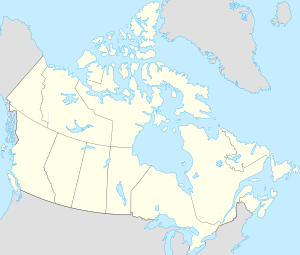Cape Uivak facts for kids
Quick facts for kids Cape Uivak |
|
|---|---|
| Location | Newfoundland and Labrador, Canada |
| Coordinates | 58°29′01″N 62°33′53″W / 58.48361°N 62.56472°W |
| Elevation | 161 metres (528 ft) |
Cape Uivak is a notable landform found in the northern part of Labrador. Labrador is a large region within the province of Newfoundland and Labrador in Canada. A cape is a piece of land that sticks out into a sea, lake, or ocean. Cape Uivak reaches into the Atlantic Ocean.
Contents
What is Cape Uivak?
Cape Uivak is a headland, which is another name for a cape. It is located on the coast of northern Labrador. This area is known for its rugged and wild natural beauty. The cape itself is part of the vast Canadian landscape.
Where is Cape Uivak Located?
Cape Uivak is situated in the northernmost part of Labrador. This region is quite remote and sparsely populated. It is part of the larger province of Newfoundland and Labrador. This province is on the eastern coast of Canada.
Geographic Coordinates of Cape Uivak
The exact location of Cape Uivak can be found using its geographic coordinates. These are like an address on a map. The coordinates are 58°29′01″N latitude and 62°33′53″W longitude. These numbers help pinpoint its spot on Earth.
How High is Cape Uivak?
Cape Uivak has an elevation of about 161 meters (528 feet) above sea level. This makes it a significant feature along the coastline. Its height allows for impressive views of the surrounding ocean and land.
The Environment of Northern Labrador
The area around Cape Uivak in northern Labrador is very unique. It has a subarctic climate, which means it is cold for much of the year. The landscape includes tundra, forests, and many lakes and rivers. This environment supports various types of wildlife.
Wildlife in the Region
Many animals call northern Labrador home. You might find caribou, polar bears, and arctic foxes. Various bird species also live here, especially during the warmer months. The ocean waters near the cape are home to seals and whales.
Climate and Weather at Cape Uivak
The weather at Cape Uivak can be very harsh. Winters are long and very cold, with lots of snow. Summers are short and cool. Strong winds are common along the coast. This tough climate shapes the plants and animals that live there.
Why are Capes Important?
Capes like Cape Uivak play an important role in geography. They often mark significant points along a coastline. Sailors and explorers have used capes for navigation for centuries. They help define the shape of continents and islands.
Capes and Coastal Features
Capes are often formed by erosion from waves and wind. They can be rocky and rugged, like Cape Uivak. They also create sheltered bays and coves nearby. These areas can be important for local ecosystems.
Historical Significance of Capes
Historically, capes were crucial for sea travel. They were landmarks that helped ships find their way. Many capes around the world have stories of exploration and adventure tied to them. While Cape Uivak is remote, it is part of this global network of coastal landmarks.


